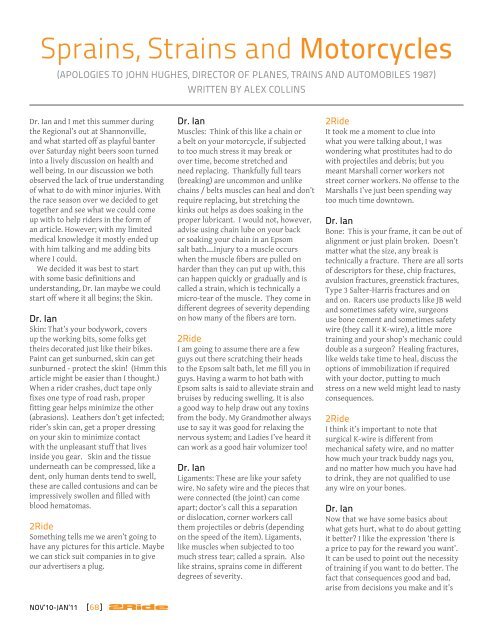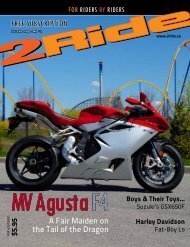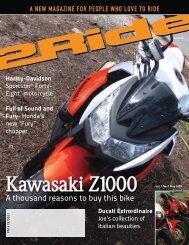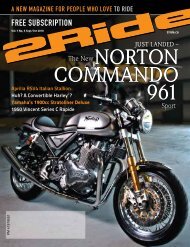Free SubScriPtioN - 2Ride Motorcycle Magazine
Free SubScriPtioN - 2Ride Motorcycle Magazine
Free SubScriPtioN - 2Ride Motorcycle Magazine
You also want an ePaper? Increase the reach of your titles
YUMPU automatically turns print PDFs into web optimized ePapers that Google loves.
Sprains, Strains and <strong>Motorcycle</strong>s<br />
(aPoLoGIeS To joHn HuGHeS, DIReCToR oF PLaneS, TRaInS anD auToMoBILeS 1987)<br />
WRITTen BY aLex CoLLInS<br />
Dr. Ian and I met this summer during<br />
the Regional’s out at Shannonville,<br />
and what started off as playful banter<br />
over Saturday night beers soon turned<br />
into a lively discussion on health and<br />
well being. In our discussion we both<br />
observed the lack of true understanding<br />
of what to do with minor injuries. With<br />
the race season over we decided to get<br />
together and see what we could come<br />
up with to help riders in the form of<br />
an article. However; with my limited<br />
medical knowledge it mostly ended up<br />
with him talking and me adding bits<br />
where I could.<br />
We decided it was best to start<br />
with some basic definitions and<br />
understanding, Dr. Ian maybe we could<br />
start off where it all begins; the Skin.<br />
Dr. Ian<br />
Skin: That’s your bodywork, covers<br />
up the working bits, some folks get<br />
theirs decorated just like their bikes.<br />
Paint can get sunburned, skin can get<br />
sunburned - protect the skin! (Hmm this<br />
article might be easier than I thought.)<br />
When a rider crashes, duct tape only<br />
fixes one type of road rash, proper<br />
fitting gear helps minimize the other<br />
(abrasions). Leathers don’t get infected;<br />
rider’s skin can, get a proper dressing<br />
on your skin to minimize contact<br />
with the unpleasant stuff that lives<br />
inside you gear. Skin and the tissue<br />
underneath can be compressed, like a<br />
dent, only human dents tend to swell,<br />
these are called contusions and can be<br />
impressively swollen and filled with<br />
blood hematomas.<br />
<strong>2Ride</strong><br />
Something tells me we aren’t going to<br />
have any pictures for this article. Maybe<br />
we can stick suit companies in to give<br />
our advertisers a plug.<br />
Dr. Ian<br />
Muscles: Think of this like a chain or<br />
a belt on your motorcycle, if subjected<br />
to too much stress it may break or<br />
over time, become stretched and<br />
need replacing. Thankfully full tears<br />
(breaking) are uncommon and unlike<br />
chains / belts muscles can heal and don’t<br />
require replacing, but stretching the<br />
kinks out helps as does soaking in the<br />
proper lubricant. I would not, however,<br />
advise using chain lube on your back<br />
or soaking your chain in an Epsom<br />
salt bath….Injury to a muscle occurs<br />
when the muscle fibers are pulled on<br />
harder than they can put up with, this<br />
can happen quickly or gradually and is<br />
called a strain, which is technically a<br />
micro-tear of the muscle. They come in<br />
different degrees of severity depending<br />
on how many of the fibers are torn.<br />
<strong>2Ride</strong><br />
I am going to assume there are a few<br />
guys out there scratching their heads<br />
to the Epsom salt bath, let me fill you in<br />
guys. Having a warm to hot bath with<br />
Epsom salts is said to alleviate strain and<br />
bruises by reducing swelling. It is also<br />
a good way to help draw out any toxins<br />
from the body. My Grandmother always<br />
use to say it was good for relaxing the<br />
nervous system; and Ladies I’ve heard it<br />
can work as a good hair volumizer too!<br />
Dr. Ian<br />
Ligaments: These are like your safety<br />
wire. No safety wire and the pieces that<br />
were connected (the joint) can come<br />
apart; doctor’s call this a separation<br />
or dislocation, corner workers call<br />
them projectiles or debris (depending<br />
on the speed of the item). Ligaments,<br />
like muscles when subjected to too<br />
much stress tear; called a sprain. Also<br />
like strains, sprains come in different<br />
degrees of severity.<br />
<strong>2Ride</strong><br />
It took me a moment to clue into<br />
what you were talking about, I was<br />
wondering what prostitutes had to do<br />
with projectiles and debris; but you<br />
meant Marshall corner workers not<br />
street corner workers. No offense to the<br />
Marshalls I’ve just been spending way<br />
too much time downtown.<br />
Dr. Ian<br />
Bone: This is your frame, it can be out of<br />
alignment or just plain broken. Doesn’t<br />
matter what the size, any break is<br />
technically a fracture. There are all sorts<br />
of descriptors for these, chip fractures,<br />
avulsion fractures, greenstick fractures,<br />
Type 3 Salter-Harris fractures and on<br />
and on. Racers use products like JB weld<br />
and sometimes safety wire, surgeons<br />
use bone cement and sometimes safety<br />
wire (they call it K-wire), a little more<br />
training and your shop’s mechanic could<br />
double as a surgeon? Healing fractures,<br />
like welds take time to heal, discuss the<br />
options of immobilization if required<br />
with your doctor, putting to much<br />
stress on a new weld might lead to nasty<br />
consequences.<br />
<strong>2Ride</strong><br />
I think it’s important to note that<br />
surgical K-wire is different from<br />
mechanical safety wire, and no matter<br />
how much your track buddy nags you,<br />
and no matter how much you have had<br />
to drink, they are not qualified to use<br />
any wire on your bones.<br />
Dr. Ian<br />
Now that we have some basics about<br />
what gets hurt, what to do about getting<br />
it better? I like the expression ‘there is<br />
a price to pay for the reward you want’.<br />
It can be used to point out the necessity<br />
of training if you want to do better. The<br />
fact that consequences good and bad,<br />
arise from decisions you make and it’s<br />
a useful acronym to remember if you<br />
get hurt. What? You say. That’s right A<br />
P.R.I.C.E: Assessments, Protect, Rest, Ice &<br />
Compress or Elevate.<br />
<strong>2Ride</strong><br />
Hold on there Doc, I don’t recall<br />
mentioning money for the article…<br />
OH! I get it, wait we didn’t talk about<br />
homework either.<br />
Dr. Ian<br />
Assessments: Get your injury looked at…<br />
by a professional, even less significant<br />
stuff. It’s easier for a healthcare<br />
professional to deal with something<br />
before it’s a big deal and when you and<br />
the doctor or therapist then have more<br />
time to help it recover. Nothing is more<br />
frustrating that trying to fix an injury an<br />
hour before a race, especially if you’ve<br />
had the problem for a week already.<br />
<strong>2Ride</strong><br />
You’re right I do notice this quite a<br />
bit, especially around the track. I can<br />
count myself as one of those people who<br />
rarely gets anything looked at; at least I<br />
use to be. I learned my lesson the hard<br />
way when I took an injury to my right<br />
hand and never had it looked at. Yep!<br />
The throttle hand; and now I find load<br />
bearing or long use very painful. To make<br />
matters worse my Doctor said it would<br />
have been an easy fix five years ago, and<br />
unfixable now.<br />
Dr. Ian<br />
Protect: Get the injury protected; this<br />
could be as simple as a proper dressing<br />
on an abrasion. I often suggest that<br />
racers stick their nose deep into their<br />
race gear, when they politely refuse (o.k.<br />
sometimes not so politely) I point out<br />
that’s the same bacteria that will be up<br />
against their exposed skin. Get things<br />
taped, supported or stretched before they<br />
get used; think of it as getting the rider<br />
through technical inspection, you spend<br />
a lot of time checking the bike…why not<br />
the racer?<br />
<strong>2Ride</strong><br />
Maybe they should start a racer tech<br />
along with the bike tech.<br />
Bacteria and infections can become<br />
serious rather fast if not treated properly.<br />
It would be a shame to see a rider<br />
without a leg simply because he didn’t<br />
look after that exhaust burn. Google<br />
informs us that there are two more<br />
common types of bacterial infections;<br />
they are Staphylococcus (staph-y-lo-coccus)<br />
and Streptococcus (Strep-to-coccus).<br />
‘Staphylococcus is most commonly<br />
known as the cause of staph infections.<br />
Streptococcus species are responsible<br />
for many cases of meningitis, bacterial<br />
pneumonia, endocarditis, and necrotizing<br />
fasciitis (the ‘flesh-eating’ bacterial<br />
infections)’ Wikipedia<br />
Dr. Ian<br />
Rest: Rest the injured body part, for the<br />
recommended time. If you think that you<br />
are healing faster, get re-assessed and<br />
when / if you ride, protect the injured<br />
body part. Get it supported, braced,<br />
taped, stretched or treated to minimize<br />
the chance for further injury.<br />
<strong>2Ride</strong><br />
I would imagine it’s the adrenaline right<br />
after an accident that keeps us active, or<br />
possibly even shock. As well I think when<br />
time wears on we get antsy and tired of<br />
waiting for our bodies to heal.<br />
Dr. Ian<br />
Ice: It’s good for inflammation, pain and<br />
it’s easy to find; at the track grab some<br />
from your neighbours cooler. How long<br />
to put it on for? Well at first it feels<br />
cold, then it starts to burn, then it goes<br />
numb, usually between 7-10 minutes<br />
depending on the body part. Use a light<br />
cloth between the ice bag and your skin<br />
to prevent an ice burn (frost bite). You<br />
can repeat this process once the area<br />
warms up to the touch, typically about<br />
an hour. Of note, don’t ice a muscle prior<br />
to exercise; it will be more stiff and more<br />
prone to injury.<br />
<strong>2Ride</strong><br />
That is interesting, I always use to ice<br />
some things but heat others. For any<br />
readers who aren’t able to get to ice,<br />
frozen products from the freezer work<br />
just as well, and can be an excuse to have<br />
steak for dinner.<br />
Dr. Ian<br />
Compress and / or Elevate: It keeps<br />
the swelling down. Swelling stretches<br />
damaged tissue and causes pain. Elevate<br />
the injured part above heart level; arm<br />
over chest if laying down or above head<br />
if sitting up, leg up while lying down.<br />
With compression, not too much<br />
pressure that you slow circulation (you<br />
can check on extremities, hands and feet<br />
by pushing at the finger/toe nail, the<br />
colour should change with pressure and<br />
then back again - white with pressure,<br />
pink without).<br />
<strong>2Ride</strong><br />
This just might be the perfect excuse<br />
to spend the afternoon watching T.V.<br />
A little bit harder at the track though…<br />
It could be the prefect excuse to set<br />
up camp in one of the air conditioned<br />
trailers hanging around.<br />
Dr. Ian<br />
Medication: As a Doctor of Chiropractic<br />
this is outside my scope of practice,<br />
however I will say this: don’t borrow<br />
someone else’s prescription medication,<br />
it was prescribed for them.<br />
<strong>2Ride</strong><br />
Even if they are related to you? There<br />
goes my afternoon plans.<br />
nov’10-jan‘11 [68] nov’10-jan‘11 [69]<br />
Thanks so much Dr. Ian, you and I always<br />
get into great medical discussion when<br />
we meet up. Dr. Ian will be working with<br />
me over the winter months to come up<br />
with some great articles for the racer and<br />
the every day rider to apply to their lives.<br />
If there is anything in particular you the<br />
reader would like to know you can send<br />
suggestions or questions to the 2ride<br />
website (www.2ride.ca) or to my e-mail<br />
Alex@2ride.ca and Dr. Ian and I can work<br />
on getting you those answers.<br />
Dr. Ian Eix is the owner of Highside<br />
Healthcare (on/off track site) and has<br />
been treating racers at road race events<br />
at RACE events and PMP Superbike<br />
Championship for a number of years. He<br />
also can be found at Royal Medical (North<br />
York) as the director of their chronic<br />
pain program. You can find him on either<br />
of his sites: www.highsidehealthcare.ca<br />
or www.royalmedicalrehab.com





